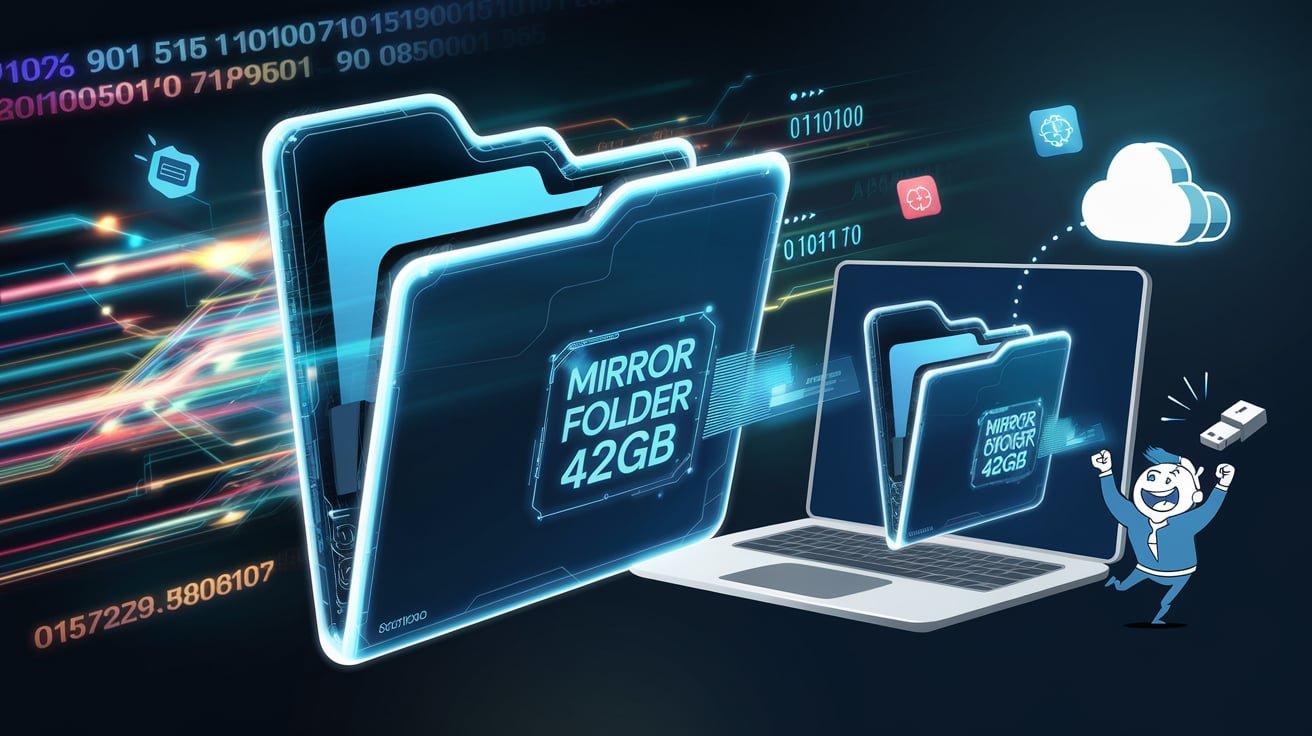
Introduction
Imagine losing 42GB of your precious data overnight—a catastrophic scenario that sends shivers down any tech-savvy spine. Enter the Mirror Folder 42GB, a powerful tool to safeguard, synchronize, and share your data seamlessly. Whether you’re an individual safeguarding family photos or a professional juggling massive projects, a mirror folder of this size is your ultimate weapon against data disasters.
In this guide, we’ll explore what a Mirror Folder 42GB is, why it’s critical, how to create one, and the tools you need to make your digital life stress-free. And yes, we’ll throw in a few laughs and profound truths along the way!
What is a Mirror Folder 42GB?
A Mirror Folder 42GB is a duplicate of a folder containing—brace yourself—42 gigabytes of data. It’s like having a twin who agrees with everything you say but lives on another device or storage platform. Any changes to the original folder are reflected in the mirrored version, ensuring your data remains consistent and safe.
This concept isn’t just geek jargon. It’s a lifesaver, especially when you accidentally delete something important. Pro tip: your laptop doesn’t have a “Ctrl+Z” for heartbreak, but a mirror folder? Now that’s close!
Why Do You Need a Mirror Folder 42GB?
Let’s face it: 42GB isn’t a tiny amount. It’s a treasure chest of high-resolution photos, videos, software backups, or maybe even your secret karaoke collection. Here’s why a Mirror Folder 42GB is non-negotiable:
- Disaster Recovery: Hardware failure? Virus attack? Human error? Your mirror folder has your back.
- Collaboration: Working on massive projects? A mirrored folder ensures your team stays in sync.
- Remote Access: Need your files while sipping coffee in another timezone? A mirror folder makes it happen.
Think of it as a digital insurance policy. And let’s be honest—42GB is no joke. It’s like carrying around a miniature vault of priceless data.
How to Create a Mirror Folder 42GB
Creating a 42 GB mirror folder isn’t rocket science. It’s more like baking a cake—follow the recipe, and you’re good to go.
Step 1: Evaluate Your Storage
First things first. Check if your target device has enough space. Remember, 42GB isn’t just “big.” It’s “start-clearing-old-movies-from-your-drive” big.
Step 2: Choose the Right Tool
The options are endless, from built-in utilities like Robocopy (Windows) to third-party apps like FreeFileSync. For cloud-based mirroring, services like Google Drive or OneDrive are game-changers.
Step 3: Sync Like a Pro
Once your tool is set, initiate the sync process. If you’re working with network storage, ensure your internet is faster than a snail on a treadmill—uploading 42GB takes patience!
Challenges of Handling a Mirror Folder 42GB
Creating a Mirror Folder 42GB might sound fancy, but it comes with its quirks:
- Time Drain: Syncing 42GB isn’t a sprint. It’s a marathon. First-timers, prepare to wait.
- Bandwidth Battle: Your internet might groan under the weight of a 42GB upload. Avoid peak hours for smoother operations.
- Hardware Hiccups: Older devices might huff and puff while mirroring large folders. Upgrade if needed.
And here’s a profound truth: If you think your old laptop is up for this task, think again. It might just start smoking—literally.
Tools for Managing Mirror Folder 42GB
With significant data comes great responsibility. Here are some tools that can make managing a Mirror Folder 42GB a breeze:
- Robocopy: For command-line ninjas. Type your magic spells, and it works wonders.
- FreeFileSync: Open-source, user-friendly, and efficient. A favorite among geeks and noobs alike.
- Google Drive is cloud-based and accessible. Ensure your plan covers 42GB—you don’t want to be “that person” with a half-synced folder.
Best Practices for Mirror Folder 42GB
So, you’ve got your Mirror Folder 42GB up and running. Now what? Follow these tips to keep it efficient:
- Automate Updates: Set up automatic sync schedules. Trust me, manual syncing is so 2005.
- Encrypt Your Data: Especially if it contains sensitive files. Encryption keeps nosy eyes away.
- Monitor Regularly: Check for sync errors. A glitchy mirror folder is as good as no folder.
Everyday Uses for Mirror Folder 42GB
The possibilities are endless, but here are some relatable scenarios:
- Photographers: Safeguard those 42GB of wedding photos—because no one likes re-shoots.
- Gamers: Keep your mods and saved worlds intact. A crash shouldn’t mean starting over.
- Corporate Gurus: Seamlessly share those mammoth Excel files and presentations.
Profound Truth: You Can’t Wing It
Here’s the deal: Managing a 42 GB mirror folder isn’t about clicking a few buttons and hoping for the best. It requires planning, patience, and the right tools. Skip any of these and set yourself up for a digital meltdown.
And remember, data loss isn’t just inconvenient. It’s expensive, frustrating, and often irreversible. Treat your mirror folder like your digital BFF—it deserves care and attention.
A Little Humor to Lighten the Load
Why did the 42GB folder apply for a job?
Because it wanted to be mirrored as the “perfect copy”!
Okay, bad joke. Your mirrored folder won’t judge.
Mirror Folder 42GB: A Comparison of Tools
| Tool | Key Features | Best For |
| Robocopy | Command-line utility, fast | Advanced users, Windows only |
| FreeFileSync | Real-time sync, multi-platform | Casual and professional users |
| Google Drive | Cloud storage, accessibility | Online collaboration |
Conclusion
Creating and managing a 42 GB mirror folder isn’t just about tech-savvyness. It’s about safeguarding your digital treasures and ensuring seamless access and collaboration. Whether you’re a photographer backing up precious moments or a business professional juggling large projects, a mirror folder of this size is your secret weapon.
Follow the steps, choose the right tools, and embrace the process. Yes, it takes effort and planning, but the payoff—a secure, synchronized, and accessible 42GB of data—is worth every second.
So mirror that folder and sleep a little easier knowing your digital world is safe and sound. After all, isn’t that what tech is all about?


